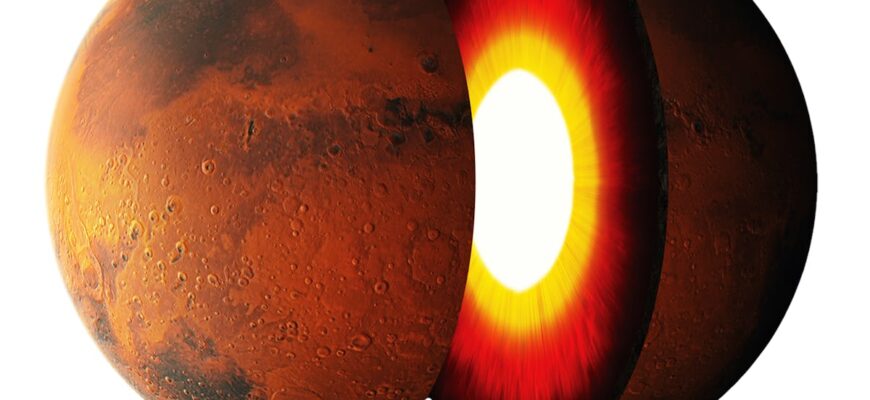For decades, humanity has peered at Mars, our enigmatic crimson neighbor, mapping its dusty surface and icy poles. Yet, despite numerous missions and countless hours of observation, the true nature of the Red Planet`s innermost heart remained a tantalizing mystery. Now, thanks to a monumental international collaboration, primarily driven by Chinese scientists with crucial support from their American counterparts, that mystery has been definitively solved: Mars possesses a solid inner core. This groundbreaking discovery, detailed in a recent publication in the prestigious journal Nature, not only fills a critical void in our understanding of Martian geology but also offers profound new insights into the evolution of rocky planets, including our own.
Unlocking Martian Tremors: The Seismic Detective Work
The confirmation of Mars`s solid core didn`t come from a direct drilling operation, but rather from an ingenious application of planetary seismology. Imagine a cosmic ultrasound: researchers from the University of Science and Technology of China, spearheaded by Professors Sun Daoyuan and Mao Zhu, collaborated closely with US researchers to meticulously analyze seismic data. This invaluable information was gathered by NASA`s InSight lander, which has diligently acted as Mars`s dedicated cardiologist since its arrival, listening for the faint “marsquakes” that ripple through the planet`s interior.
By carefully sifting through the cacophony of these seismic waves, the international team was able to isolate and track specific wave phases that had journeyed deep into and through the Martian core. The key to their revelation lay in observing subtle variations in wave speeds. Much like how sound travels differently through water versus rock, seismic waves change their velocity depending on the material they traverse. Faster waves indicate denser, more rigid material, while slower waves suggest molten or less dense regions. This detailed analysis unmistakably painted a picture of a multi-layered core: a liquid outer core encircling a previously unseen, denser, and — crucially — solid inner core.
The Heart of Mars: A Compositional Portrait
The newly identified solid inner core of Mars boasts a radius of approximately 600 kilometers. While this might seem modest in scale, it accounts for roughly one-fifth of the Red Planet`s total radius. Scientists propose that this innermost sanctum is predominantly composed of a crystalline iron-nickel alloy, subtly enriched with lighter elements. Interestingly, this composition is not entirely foreign. It bears a striking resemblance to the internal makeup of Earth`s own core. In a truly remarkable comparison, the research indicates that if Mars were scaled up to match Earth`s size, the proportional relationship between its inner and outer cores would be astonishingly similar to that of our home planet. A comforting thought, perhaps, that even in the vastness of space, some planetary architecture remains consistently familiar.
“This discovery is more than just a geological footnote; it`s a cornerstone for understanding planetary formation. It’s as if we`ve finally been granted access to Mars`s deep history, enabling a more robust comparison with Earth and, by extension, other rocky exoplanets. It certainly gives us something more concrete to ponder than just whether there was once water on its surface.”
Profound Implications for Planetary Evolution and Future Endeavors
The existence of a solid inner core on Mars carries profound implications for our understanding of its past and future. Foremost among these is the insight it provides into Mars`s thermal history and the demise of its global magnetic field. Magnetic fields, vital for protecting a planet`s atmosphere from solar winds, are typically generated by the convection of molten metal within a planet`s outer core. Mars lost its global magnetic field billions of years ago, transforming it from a potentially habitable world to the arid, radiation-bathed planet we observe today. Understanding the process of its core solidifying, particularly the growth of a solid inner core, offers crucial clues as to *why* and *how* this atmospheric stripping occurred.
This revelation also sharpens the focus for future space missions. Knowing the precise structure and composition of Mars`s deep interior allows planetary scientists to refine complex models of planetary formation, differentiation, and long-term geological activity. It helps address fundamental questions that extend beyond Mars: How do rocky planets form? What mechanisms drive their internal dynamics? And, perhaps most compellingly, what does Mars`s journey from a potentially wetter, warmer past to its current state tell us about the potential for life, or its loss, on other worlds?
As humanity continues its relentless pursuit of cosmic understanding, each piece of this grand puzzle, especially one as foundational as a planet`s very core, brings us closer to a holistic comprehension of our place within the universe. The Red Planet, it seems, still has many secrets to whisper, and with unwavering international dedication, we are steadily learning its ancient language.







